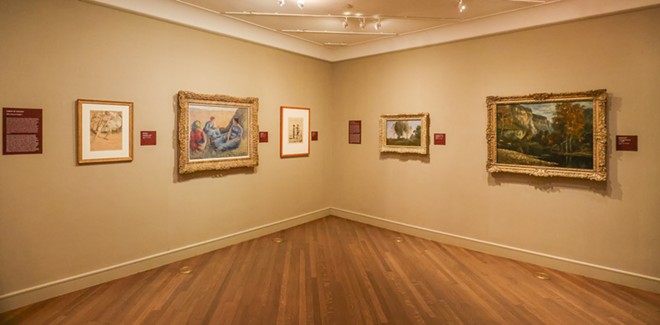
Jonathan Rinck
The McNay’s “A Explicit Magnificence” shines new gentle on nineteenth century French prints, work and drawings from its everlasting assortment.
This yr marks the seventieth anniversary of the McNay Artwork Museum, house to greater than 22,000 artworks, which match largely throughout the framework of the European “canon.” Nonetheless, the present “A Explicit Magnificence” highlights narratives and asks questions which have typically been excluded from art-historical discourse.
The exhibition presents a small however thought-about collection of nineteenth century French prints, work and drawings from the museum’s everlasting assortment and exhibits them in a brand new gentle, utilizing the works to replicate on a broad vary of subjects spanning ecocriticism, race, incapacity research and different points. It’s a small present, but it surely brings collectively a wonderful collection of blue-chip artists that carry severe weight.
“A Explicit Magnificence” is curated by Noelle Yongwei Barr, the McNay’s 2022/23 Semmes Basis Intern in Museum Research. That includes 12 works, the present is split into 4 sections: Exoticism, Gendered Areas, Leisure and Labor, and Our bodies of Nature. Textual content on the wall poses questions equivalent to “What’s Exoticism?” and “Who has Privilege?”
On view for the primary time on the McNay is an Odalisque by Ingres — pronounced type of like “aang-gruh.” The print is a lithographic iteration of his well-known portray of the identical identify within the Louvre. It depicts a languidly posing concubine located with Oriental props.
Following Napoleon’s conquest of Egypt and Syria, and later France’s colonization of Algeria in 1830, many European artists loaded their work with fanciful references to Japanese cultures, a phenomenon author Edward Stated known as “Orientalism.” Ingres’ Odalisque and Renoir’s adjoining Gabrielle in Oriental Costume collectively stand as a textbook examples of European portrayals of the exoticized “different.”
A trio of works in “A Explicit Magnificence” deal with the theme of gendered areas.
Like lots of his works, Degas’ depictions of ladies — such because the Bather, on view right here — are uncomfortably voyeuristic, seeming to seize his dancers and bathers as in the event that they have been unaware of his — and our — presence.
Nonetheless, an accompanying drypoint engraving by Berthe Morisot speaks to feminine company. Morisot, whose luminous impressionist work have been featured in seven of the eight unique impressionist exhibitions in Paris, usually doesn’t seem in her personal works. However within the little engraving The Drawing Lesson, we see her within the function of trainer, giving her daughter a type of improvised artwork lesson. This at a time when artwork was nonetheless largely thought to be a gendered career, and the ranks of the French Royal Academy of Artwork was virtually fully male. It’s a refined work through which Morisot leans in to her roles each as a mom and an artist.

Jonathan Rinck
“A Explicit Magnificence” is a small present, but it surely’s bold in what it units out to do.
A number of works deal with “Labor and Leisure” towards the context of privilege, whether or not social, gender or financial, and we’re invited to contemplate that of their work, many of those artists approached labor from the comfy vantage level of the bourgeois. It’s a stress we really feel in Pissarro’s Haymakers Resting, one of many gems of the McNay’s assortment, its flecks of paint rendered within the artist’s fastidious pointillist fashion.
However the picture of three girls prettily resting, backlit by a stunning sunlit area undermines the fact is that the trio is taking a break from doing severely laborious work. Millet’s extra un-romanticized etching The Stroll to Work is more likely to resonate with us who battle the dreary morning commute on Loop 410.
The present concludes with a set of landscapes, and the present’s didactic textual content makes the purpose that these have been created at a time when Paris was aggressively modernizing below Baron Haussmann and that Parisians of means discovered refuge within the countryside, definitely talking to privilege. These giant work by Corot, Corbet and Manet, all of who utilized the paint in deliciously thick impasto, visually anchor the present with their commanding presence within the gallery area.
The exhibition has a pair methods up its sleeve. It’s the McNay’s first present to be obtainable on the app Bloomberg Connects, which makes the present’s works and accompanying essay and wall textual content utterly obtainable on-line. And in an effort to make the museum expertise extra inclusive, some wall textual content is supplied in Braille, and a tactile expertise that permits guests to really feel a textural illustration of the free brushwork of Pissarro’s Haymakers. Descriptive audio textual content and an exhibition catalog can be found on the McNay’s web site.
“A Explicit Magnificence” is a small present, but it surely’s bold in what it units out to do. Maybe it even tries slightly too laborious. Every of this exhibition’s 4 themes may in all probability be their very own present. Even so, “A Explicit Magnificence” manages to take questions and concepts which have been circulating in academia and current them publicly in an accessible, participating and eminently digestible means.
“A Explicit Magnificence” is on view on the McNay by way of June 16.
Subscribe to SA Present newsletters.
Comply with us: Apple Information | Google Information | NewsBreak | Reddit | Instagram | Fb | Twitter| Or join our RSS Feed





